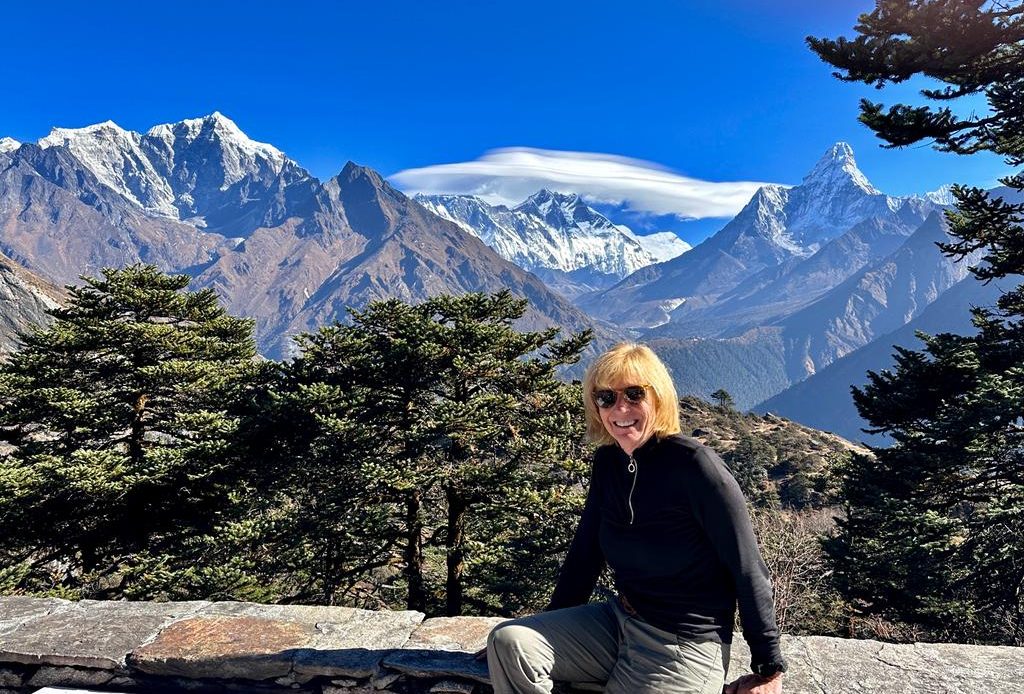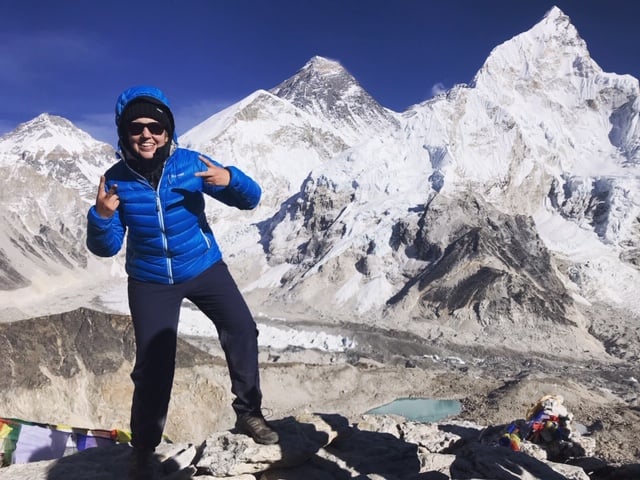The Annapurna Circuit Trek vs Everest Base Camp Trek offers incredible Himalayan adventures. However, the choice depends on your preferences, interests, and the kind of experience you are seeking. Whether it is the cultural immersion of the Annapurna Circuit or the iconic height of the Everest Base Camp, both journeys offer unforgettable mountaineering experiences.
Each trek has its own set of significance and challenging aspects. The altitude-related problems can prevail more as the trek involves longer periods at higher elevations during the EBC trek. If you prioritize cultural diversity and the range of varying landscapes, the Annapurna Circuit trek may be the perfect one. However, if you seek the iconic mountain view and the historical context of Everest, embark on the Everest Base Camp trek. Consider your trekking experience, physical fitness, and personal preferences while deciding. Both treks offer incredible adventure, which comes down to the type of experience you are looking for.
About Annapurna Circuit Trek
Annapurna Circuit Trek is a remarkable journey, spanning approximately 160-230 kilometers (100-145 miles), encircling the Annapurna Massif. It is a renowned trekking route in the Annapurna region of Nepal and a popular Himalayan trekking adventure in the world. Annapurna Circuit trek offers a kaleidoscope of topographies from charming subtropical forests to alpine meadows and high mountain arid landscapes.
The Annapurna Circuit is the cultural odyssey, highlighting the diverse ethnicities like Gurung, Thakalies, and Manangies and the charming bio-diversity of the Annapurna Conservation Area. The trek reaches its zenith at the Thorong La Pass (5,416 meters / 17,769 feet), with panoramic views of the magnificent array of peaks like Annapurna, Dhaulagiri, other surrounding peaks, and the Mustang region. With a remarkable experience with the transitioning terrains, the Kali Gandaki George (one of the world’s deepest) adds to the trek’s geographical significance.
Table of Contents
About Everest Base Camp Trek

The Everest Base Camp Trek is an awesome Himalayan adventure through the heart of the Khumbu region. Everest Base Camp (EBC) lies on the foothills of the iconic Mount Everest(8,848 meters / 29,028 feet) at an altitude of 5,364 meters / 17,598 feet. The starting point of the EBC trek is Lukla, a gateway to the Everest region. The adventure of tracing the banks of the Dudh Koshi River meanders through the Sagarmatha National Park. The trek follows the picturesque Sherpa Villages to reach the Namche Bazaar. This vibrant market town is a popular acclimatization destination, offering an awe-inspiring view of Everest and surrounding peaks.
The trek is a challenging yet beautiful journey due to the amazing scenery of the charming forests, terraced farmlands, and breathtaking Himalayas. The trek continues to Tengboche, Dingboche, and Lobuche, with magnificent mountain views of Nuptse, Lhotse, Makalu, Ama Dablam, etc., on the way. Upon continuing the journey, the trek leads to Gorakshep and then to Khumbu Glacier, with an amazing view of the stunning Khumbu icefall. Walking alongside the Khumbu Glacier, we reach the iconic Everest Base Camp at the lap of the world’s highest peak with a sense of accomplishment.
Annapurna Circuit Trek Vs Everest Base Camp Trek Highlights

- The Annapurna Circuit trek involves traversing diverse landscapes, from lush forest areas, terraced fields, barren landscapes, and picturesque villages to high mountain desert-like terrains. For the EBC trek, start the journey with a thrilling flight to the gateway of the Everest region, Lukla, with amazing aerial views of the mountains, and then continue by exploring the vibrant and bustling Sherpa town of Namche Bazaar with traditional architecture.
- The Annapurna Circuit trek crosses Thorong La Pass, one of the world’s highest trekking passes, whereas the EBC trek crosses the high-altitude pass, Cho La Pass, enhancing the trek’s adventure.
- The Annapurna Circuit Trek provides panoramic views of the amazing mountain peaks like Macchapuchre, Dhaulagiri, Manaslu, Annapurna range, and many more. Enjoy the spectacular views of Himalayan Peaks like Everest, Nuptse, Lhotse, Ama Dablam, and other surrounding peaks during the EBC Trek journey.
- Explore the diverse ethnic villages of the Annapurna region, like Manag, Pisang, and Marpha, with rich insights into local communities’ culture, traditions, and hospitability. During the EBC trek, explore the rich Sherpa culture and lifestyle while interacting with the localities known for their warm hospitality.
- Visit the pilgrimage site Muktinath Temple, a religiously significant place for Buddhists and Hindus with 108 water spouts and external flames during the Annapurna Circuit trek. Visit the ancient monastery, Tengboche, for a spiritual experience of the EBC trek.
- Tatopani’s natural hot spring has healing properties, offering a soothing break for tired trekkers.
- Trek along the Kali Gandaki George for the Annapurna Circuit trek and traverse the amazing Dudh Koshi River bank for the EBC trek.
- Experience the biodiversity of the Annapurna Conservation area, forests, animals, and diverse bird species during the Annapurna Circuit trek while exploring the diverse and elusive plants and wildlife of Sagarmatha National Park in the EBC trek.
Best Time

The best time for Himalayan trekking is Spring (March to May) and Autumn (September to November). Spring and Autumn are the favorable seasons that offer stable weather conditions, dry trails, beautiful landscapes, and undisturbed mountain views. The sharp view of the amazing mountain topography, as provided by the clear sky, is fascinating.
There is no chance of snowfall or rain interfering with the tour schedules. The chance of undesirable incidents is also minimized owing to dry trails. These are the ultimate seasons for the best Annapurna Circuit and Everest Base Camp Trek experience. The particular months in these seasons coincide with festivals, allowing you to explore the cultural prospects of the localities in the festive vibe.
Spring
The Spring in the Annapurna and EBC trek
- Spring in the Himalayan trek is the blooming season with vibrant colors.
- The picturesque environment in both regions, with lush vegetation and blooming landscapes.
- Milder temperatures and stable weather
- High chance of witnessing rare animals and migratory birds.
- Clear mountain views in clean and stable weather conditions.
- Extended daylight hours.
- Comfortable teahouses and lodging facilities along the trail.
- Spring is a popular trekking season, with more trekkers on the trail (Annapurna Circuit is less crowded than EBC).
Autumn
The Autumn in the Annapurna and EBC trek
- Autumn is a suitable season for Himalayan trekking, including the Annapurna Circuit and EBC, with unobstructed views of the Himalayas on clear days.
- Lush Himalayan terrains washed by the monsoon showers.
- Autumn marks the festive celebrations of Dashain and Tihar, allowing trekkers to explore the region’s cultural prospects.
- Mild trekking temperatures in both the Annapurna Circuit and EBC trek.
- Clear skies and panoramic mountain views are available in both regions.
- Vibrant topographies are decorated with the amazing autumn shades in both regions.
- High visibility for stunning Himalayan photography.
- Less crowded trekking trails than in the spring.
- Autumn offers delectable cuisine of the harvest season to both treks.
- Booking accommodations for the Annapurna Circuit and Everest Base Camp Trek is highly recommended.
Read this next:
Temperature of the Annapurna Circuit vs EBC

The temperature differences in the Annapurna Circuit and EBC are significant due to their distinct geographical locations. The temperature in both regions depends on the trekking season and the altitudes. Normally, the EBC trek occurs at higher altitudes than most parts of the Annapurna Circuit, which tends to be colder. Both regions’ temperatures can range from mild to extremely cold, minus temperatures in higher elevations during the winter. Generally, you can expect the night temperature to be minus degrees above 4,000 meters.
The Annapurna Circuit temperatures in the lowland around 800 meters can range from 10 to 25 degrees Celsius. As you ascend, the temperature drops, reaching 0 to 10 degrees at higher altitudes around 3,000 meters. At Thorong La Pass’s highest point, the temperature can plummet to -10 to -20 degrees. Preparing with layered clothes is crucial to deal with the temperature fluctuations.
The EBC temperature in Spring can range from 15 to 20 degrees Celcius at lower altitudes, with night temperature around -5 to 5 degrees Celcius. During the fall, the daytime temperature can range from 15 to 20 degrees Celcius, and night can be cold, with temperatures ranging from -10 to 0 at higher elevations. In winter, temperatures drop significantly, with daytime temperatures ranging from 5 to 10 degrees Celcius at lower altitudes and much colder temperatures at higher elevations falling below -15 degrees at night.
Difficulty level

The difficulty level of each trek varies based on the trekker’s preferences, experience, physical fitness, duration, and many more reasons. The general comparison of the Annapurna and EBC trek difficulty levels can be made by analyzing the common factors involved in each trek.
The Annapurna Circuit Trek is a longer trek covering many topographies, including sub-tropical lush forests, terraced fields, and high alpine terrains. Thorong La Pass is the trek’s highest point, with an elevation of 5,416 meters / 17,769 feet. Harsh and unpredictable weather conditions can prevail at the higher altitude sections. Likewise, the chance of altitude-related problems prevailing is higher. The circuit offers a gradual increase in altitude, which is advantageous for acclimatization.
The EBC trek is generally shorter than the Annapurna trek in duration. The Everest Base Camp trek usually takes 12 to 16 days, whereas the Annapurna Circuit trek takes around 18 to 22 days, depending upon factors like the chosen route, starting point, and trekker’s ability. The Everest Base Camp trek passes through varied terrains, including rocky paths, rugged landscapes, and steep ascents. It involves the higher altitudes at the Base Camp with 5,364 meters / 17,598 feet. Altitude issues will be more pronounced at this height.
Any mountain trek, including the Annapurna Circuit and EBC, is strenuous, requiring much energy, yet possible through strong dedication and determination. The difficulty of each trek can be managed by trekking at proper trekking time with effective planning. EBC trek tends to go a little higher than the Annapurna Circuit and is slightly more challenging, with more basic facilities at the higher altitudes.
Altitude Sickness

Altitude sickness is possible in both treks, Annapurna Circuit and EBC, involving significant altitude gain. The ascent pace is important in altitude sickness, so both treks must follow the gradual ascent, allowing for acclimatization stops and rest days to minimize the probability.
The two treks can differ in altitude profiles and acclimatization strategies.
Annapurna Circuit reaches high altitudes, with the highest point Thorong La Pass at 5,416 meters / 17,796 feet, and the high hills villages like Manag and Yak Kharka. Generally, acclimatization is done in Manahf to adjust to altitudes before crossing the Thorong La Pass. The EBC trek passes through key points like Namche Bazaar (3,440 meters / 11286 feet), Dingbohe ( 4,410 meters / 14,468 feet), and Gorak Shep (5,164 meters / 16,942 feet). The trek culminates at the Base camp at around 5,364 meters / 17,598 feet. The trek generally involves the acclimatization day at Namche Bazaar and Dingboche to help trekkers adjust to the higher altitudes.
Acute Mountain Sickness (AMS), like headache, fatigue, and nausea, occurs at altitudes above 2500 meters / 8200 feet, which both treks exceed. Factors like fitness level, hydration, and genetics can contribute to the susceptibility to altitude sickness.
Trekking Distance of the Annapurna Circuit Vs EBC Trek

The Annapurna Circuit Trek and Everest Base Camp Trek consist of different trekking distances. The trekking distance is impacted by the specific route taken for each trek.
Annapurna Circuit Trek Distance
The total distance for the Annapurna Circuit Trek ranges from 160 kilometers (100 miles) to 230 kilometers (143 miles). The trekking distance can oscillate depending on the route selected. The Annapurna Circuit Trek passes diverse landscapes and encircles the Annapurna Massif. Key points include villages like Besisahar, Manag, and Jomsom, and the highest point is Thorong La.
Everest Base Camp Trek Distance
The round-trip distance for the EBC trek, which starts and ends in Lukla, is around 130 kilometers (87 miles). The trek involves ascending and descending in the Khumbu region, traversing villages like the Namche Bazaar, Tengbohje, etc. The side trip hike to Kala Patthar can add extra distance to the EBC trek journey.
Note: Both treks involve significant distances in varying terrains and ascends from low-altitude villages to high-altitude mountain passes. The pace of the trekker, acclimatization stops, and rest days also impact the duration of each trek.
Remoteness
The Annapurna Circuit and Everest base camp trek offers different experiences of remoteness. The specific route taken in each trek defines the level of remoteness.
- The Annapurna circuit has become more accessible with the construction of roads, allowing for earlier transportation. However, there are still remote and less trekked parts.
- Everest base camp is typically more popular and traveled, especially in the Khumbu region. Trekking involves passing through several villages, resulting in more infrastructure for trekkers.
If you prefer a trek with a sense of isolation and remoteness, consider the less traveled routes within the Annapurna Circuit.
Weather Factors
The weather conditions on the Annapurna Circuit Trek and EBC Trek vary due to differences in altitude and geography.
Altitude:
The Annapurna Circuit Trek reaches a high altitude, including the Thorong La Pass, at about 5,416 meters / 17,769 feet. The trek to Everest Base Camp takes you to the highest altitude, around 5,364 meters / 17,598 feet, which is the Base camp itself.
Weather:
The Annapurna Circuit weather can vary from sub-tropical regions to alpine and even arctic-like conditions at higher elevations. Climate differs as per the varying landscapes along the trail. The Everset Base camp weather is cooler at high elevations. The temperature can be significantly low, involving the journey through alpine and sub-alpine zones.
Seasonal variation: Both treks experience distinct trekking seasons with stable weather and enhanced visibility.
Monsoon impact: The monsoon season (June to August) can affect both treks. Heavy rainfall leads to slippery trails, leeches, and possible landslides in the trek.
Note: Weather conditions can vary unexpectedly at the high altitudes. Hence, trekkers should be prepared for temperature and weather variations and equipped with proper clothing and gear.
Food and Accommodation

The food and accommodation experience on the Everest Base Camp and Annapurna Circuit Trek can differ based on the infrastructure along each route.
Annapurna Circuit Trek
Food
The Annapurna Circuit offers a mix of local and international cuisines. In lower altitudes, you may get a wide range of fresh delicacies. The teahouse and lodges menu covers items like dalbhat (traditional Nepali dish), pasta, noodles, etc.
Accommodation
The accommodations along the Annapurna Circuit can vary. In some parts, there can be well-established teahouses with modern amenities. However, accommodations can be more basic in remote or less traveled sections. The teahouse offers shared bedrooms, bathrooms, and a common dining space.
Everest Base Camp Trek
Food
The Khumbu region, the higher region of the Everest trek, has relatively developed infrastructures. The teahouses and lodges provide a variety of dishes, including local and Western food options. Diverse food choices like soups, pasta, rice dishes, chowmein, steak, etc., are available.
Accommodation
Teahouses along the Everest Base Camp Trek are generally well established, offering basic but comfortable accommodations. As the trek in the Everest region is frequent and popular, teahouses can get crowded during the peak trekking seasons.
Note: As you ascend higher altitudes in both treks, food options become more limited, and the prices increase due to the transportation challenges. However, both treks offer unique culinary experiences and accommodations.
Permits

The adventurous Himalayan journey, including the Annapurna Circut and EBC trek, is possible through obtaining essential permits. The Annapurna Circuit and EBC trek permit serve several purposes: ecological preservation, security surveillance, and regulation of tourism activities. Permits grant permission for trekkers to undertake a trek route in a particular trekking destination. The permit types can differ for various trekking destinations. Likewise, the trek permits for Annapurna Circuit and Everest Base Camp differ in terms of the particular area covered. The trek permits for each trekking destination are categorized into two types.
- TIMS (Trekker’s Information Management System)
- National Park Permits
TIMS
The TIMS permit is required for both the Annapurna Circuit and Everest Base Camp trek. TIMS is a trekking registration to track trekkers on the trekking trails. A TIMS card is required for EBC and the Annapurna trek for a safe journey. Tekker’s name and travel details registered into the system can be accessed for rescue purposes in emergencies. The TIMS fee for each trek, EBC, and the Annapurna Circuit is Rs 2,000, approximately 16 USD.
National Park Permits
Annapurna Conservation Area Permit
ACAP is the Annapurna Conservation Area’s entry permit, which you must pass through for the Annapurna Circuit trek. ACAP costs Rs 3,000, which is approximately 22 USD.
Sagaramatha National Park Permits
Trekkers need the Sagarmatha National Park Permit for the EBC trek as it passes through the National Park. It costs USD 30, which is around Rs 4,000 per trekkers.
You can obtain both of these permits in Kathmandu. The trekking agencies will handle the necessary permit arrangements on your behalf. Simply provide them with the necessary information, including a photocopy of your passport and two passport-sized photos. Get the Annapurna Circuit and EBC trek permits and keep them secure for an undisturbed trekking journey.
Read this next:





